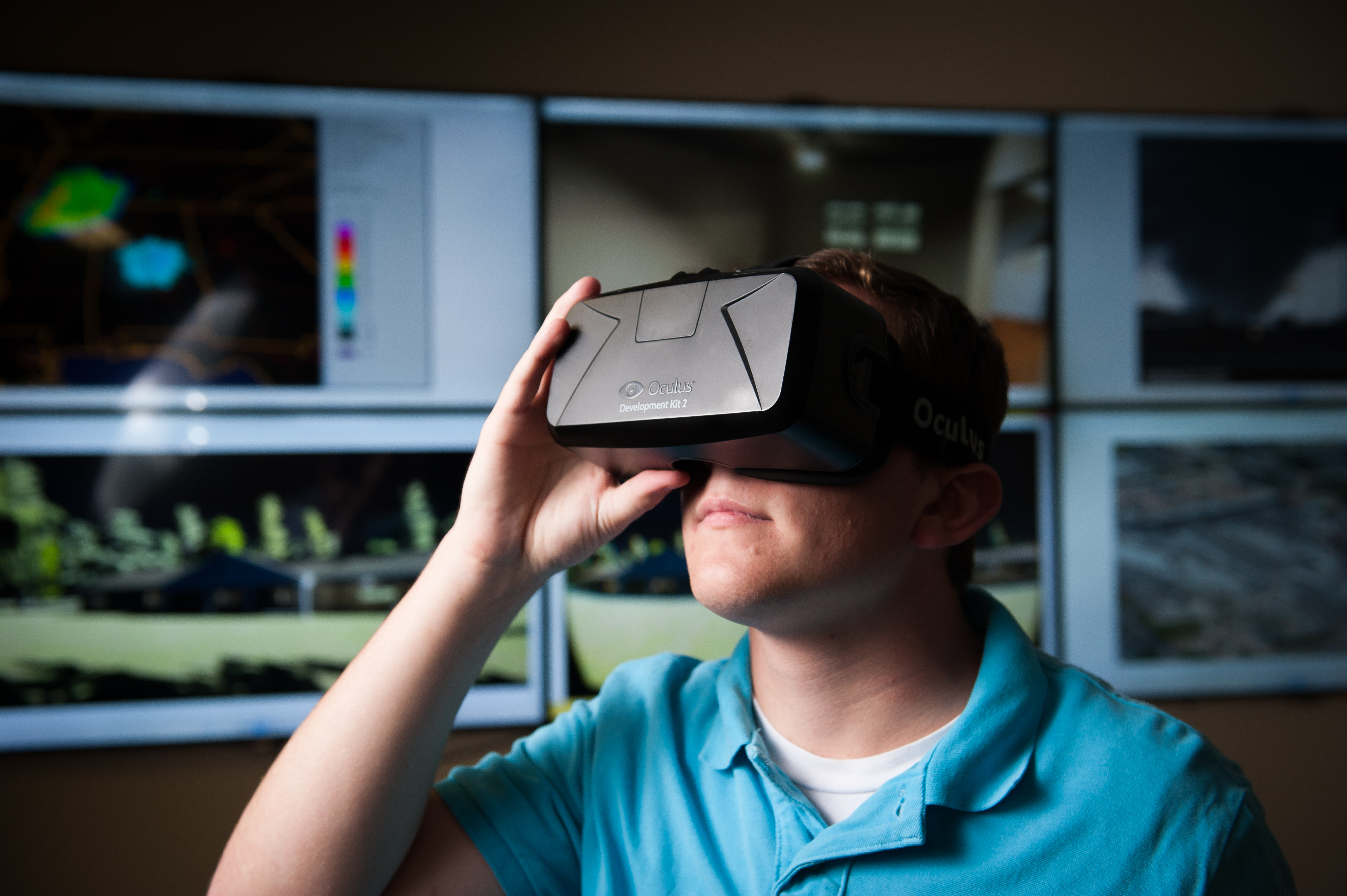By Adam Jones and David Miller
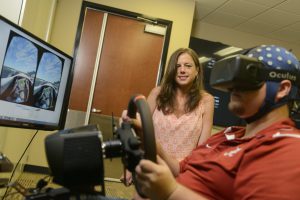
There are typically two types of automobile drivers: cautious drivers and those who push the speed limit and take turns a bit sharper than most.
While drawing a distinction between the two is simple based on experiences, University of Alabama researchers believe those who score high in sensation-seeking activities, like driving fast or riding a roller coaster, have different neural processes than low sensation-seekers.
Unfortunately, the researchers do not have roller coasters and closed race courses handy to test the theory. Instead they have a technology quickly becoming not just a close substitute for real-life experiences, but, as far as the brain is concerned, actual real-life experience, summed up neatly in the term “virtual reality.”
In a campus lab, Dr. Rick Houser, an education researcher, and Dr. Brandon Dixon, a computer scientist, use virtual reality technology to simulate high-thrill activities, like driving a Formula-1 race car, to measure neural activity of participants.
The project is one of a growing number of uses of the VR technology from disciplines across campus. Helped by the technology-driven UA Center for Advanced Public Safety, researchers are building a VR and visualization lab on campus designed to spur research.
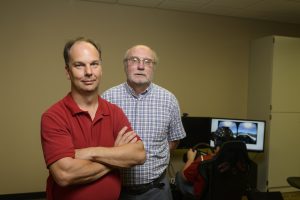
“This opens up some very interesting interdisciplinary projects,” says Dixon, who helps manage the lab for CAPS. “We have neuroscience, social work, severe weather and all kinds of things going on. The applications are going to grow, and the number of projects is only going to increase.”
The concept of virtual reality has been around a long time, and it seemed the technology was ready to take off about a quarter century ago as video games and high-end VR simulations hit the market. But immersing a person in a virtual world had problems, such as delays in reaction time. So, the technology never advanced beyond low-end uses.
“It’s less of a silly tinker toy now,” Dixon says. “Ten years ago VR was not really believable. The lag and lack of image quality would have prevented you from buying into the idea that you are really there.”
Now, though, VR technology is better partly because computers are better, rendering realistic worlds that can be moved quickly on a screen instead of the blocky graphics of the 1990s, Dixon says. The VR goggles and interface with the body are also much better, he says.
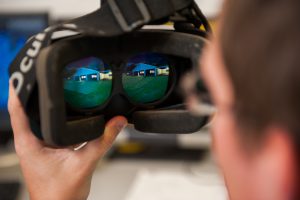
Also, it’s more affordable, so the technology is at a point where academic researchers can begin using VR to answer questions in a range of fields.
“Now that this technology and hardware is here, we’ve got to figure out what’s even possible and what makes sense,” Dixon says.
One of the early users of the lab was Houser. He’s using an intensive VR experience to differentiate between high and low impulsive individuals.
“Previous research suggests that the left dorsolateral prefrontal cortex is activated in high sensation seekers or high risk takers,” Houser says. “So, for instance, is that more activated in those individuals when they’re going faster? I’m sent the driving record, so I match up the EEG (electroencephalogram) with the driving record.”
Participants in the research sit in a replica of a racecar cockpit, outfitted with pedals, a racing seat and gear shifts to enrich the experience. Using Oculus Rift technology and custom VR hardware and software, the simulation can be set to different courses at varying degrees of difficulty. The sensation of losing control of the car is felt in the seat and simulated through the virtual reality goggles, causing a disorienting feeling to simulate G-forces.
Houser says the assessment will also measure the difference between high and low impulse individuals: in sensation seeking after experiencing a high intensive virtual reality experience, on physiological measures such as heart rate and respiration, and on speed in completing a high speed racing game, Radial G.
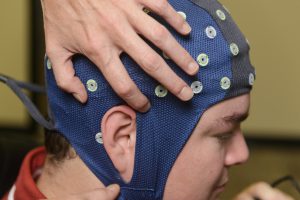
Depending on results, an intervention model could be created to change the neural processes for those who seek out negative ways of satisfying the need for high arousal, such as drug and alcohol abuse or risky sexual behavior, he says.
“We could use transcranial direct current stimulation (tDCS) to reduce activity in this region of the brain,” Houser says. “The negative electrode in tDCS has been associated with decreasing activity in neurons where it is applied, e.g. we may apply tDCS in the left dorsolateral prefrontal cortex for those whom are high sensation seeking in an effort to moderate the sensation seeking. We could monitor, for example, drug and alcohol use after using low current brain stimulation.”
Dixon, in computer science, and students from the discipline are part of the research through the software designed for the experiments.
“We’re trying to be involved on the software development front so we can facilitate and get the kind of skills and knowledge to support those projects and know what’s going to work and not work,” he says.
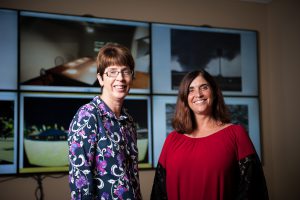
The collaborations come from across campus. Dr. Amy Traylor, with the School of Social Work, partners with the College of Engineering to help design virtual environments for several projects. With funding from the National Institutes of Health, Traylor will develop and test virtual environments aimed at providing a novel intervention component for adolescents receiving treatment for marijuana use. The virtual environments will be constructed after conducting focus groups with adolescents and staff members at The Bridge, a substance abuse treatment facility for children ages 12-18 in Tuscaloosa.
“We have great adult environments, but, for a kid, they wouldn’t be very realistic,” Traylor says. “The focus group will help us get a better idea for what a pot-smoking environment is for these kids. Once we create it, we’ll see if it elicits the reactions we want, like what drives their cravings. Further down the road, we could look at using it in treatment situations.”
Software developers within computer science and CAPS are also working to develop virtual worlds for use in research at the intersection of social science and weather. Dr. Laura Myers, a social scientist, works with Traylor to use VR to help survivors of severe weather manage anxiety that can come when new storm systems threaten.
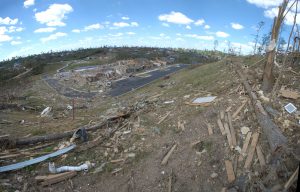
“Around here all you have to say to people is the word ‘tornado,’ and people get upset, so people are looking for ways to help that problem,” Myers says. “Virtual reality is a non-invasive way to desensitize you to what scares you – in this case, a severe weather situation.”
Many survivors of severe weather such as tornadoes or hurricanes have manageable levels of anxiety, but some develop Post Traumatic Stress Disorder, a much more serious mental health issue where storms trigger emotional responses, she says.
VR can put those suffering from the disorder into a controlled, but realistic environment, allowing them to navigate in real-time what they should do if caught in a severe weather situation. The hope is it will allow them to deal with future weather events safely, she says.
Software developers are also working to build environments that help train first responders or school children, for example, in how to handle a severe weather situation. Like the anxiety simulations, this could help people act quicker and with more knowledge when a real situation arises, Myers said.
“There’s a lot of interest in this in the weather enterprise,” Myers says.
Dr. Dixon is an associate professor of computer science, Dr. Houser is a professor of counselor education, Dr. Myers is executive director of UA’s Center for Advanced Public Safety, and Dr. Traylor is an assistant professor of social work.
